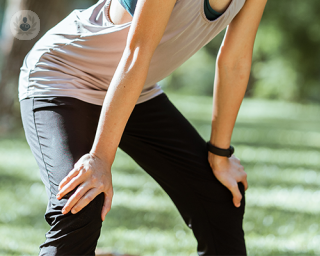What is hip osteoarthritis?
Hip osteoarthritis is a degenerative disease of the cartilage that covers the joint of the pelvic and femoral bones. This tissue facilitates movement between the bones and prevents them from rubbing against each other directly. When the cartilage decreases in thickness and texture, or is lost completely, the mechanism between the femur and the pelvis no longer functions correctly, resulting in hip osteoarthritis. It can vary in severity, from mild to severe.

What is the outlook for osteoarthritis?
Hip osteoarthritis is a chronic disease and usually progresses slowly over many years. It is one of the most common types of osteoarthritis.
What are the symptoms of hip osteoarthritis?
The main indicator of this condition is pain, which is primarily located in the groin area. Symptoms such as stiffness and impaired functionality (mobility) may also be present. The pain may sometimes radiate down the front of the thigh and also affect the knees, which might lead you to think that the problem is with the knee.
What are the medical tests for hip osteoarthritis?
In order to diagnose hip osteoarthritis, the specialist will:
- Ask questions about your symptoms and ask you to describe them.
- Examine the hip joint and its movements. This enables the specialist to assess the degree of osteoarthritis.
- X-ray the hip, to confirm the diagnosis.
- MRI scans may also be used.
What causes hip osteoarthritis?
The causes of hip osteoarthritis are numerous and results from a combination of genetic and environmental factors.
Some of the secondary factors that cause hip osteoarthritis, either combined or in isolation, are:
- Obesity
- Older age
- Professional activity
- Excessive strain on the joint due to high-intensity sport
- Malformations
Can hip osteoarthritis be prevented?
One of the causes for the onset of hip osteoarthritis is ageing, making it impossible to avoid the disease. However, onset of the disease can be significantly delayed.
The main actions you can take to try to prevent hip osteoarthritis are to:
- Lose weight
- Do physical exercise. This includes exercising the hip joints.
- Avoid movements that cause pain
- Use canes or crutches
- Follow a good diet
How is hip osteoarthritis treated?
There is currently no treatment that can cure hip osteoarthritis, but it can relieve symptoms, slow the progression of the disease and improve quality of life. There are several alternatives available:
- Weight control
- Correction of anatomical malformations or alterations
- Physical exercise
- Medication
- Surgery: replacement of the joint with an implant. This is usually performed for severe cases of the disease.
Physical measures and medication can be considered conservative treatments, the aim of which is to minimise pain and immobilisation and to slow down the progression of the disease as much as possible.
Which specialist treats hip osteoarthritis?
Rheumatologists and orthopaedic surgeons would diagnose and treat hip osteoarthritis.
11-13-2012 11-09-2023Osteoarthritis of the hip
Mr Tom Pollard - Orthopaedic surgery
Created on: 11-13-2012
Updated on: 11-09-2023
Edited by: Karolyn Judge
What is hip osteoarthritis?
Hip osteoarthritis is a degenerative disease of the cartilage that covers the joint of the pelvic and femoral bones. This tissue facilitates movement between the bones and prevents them from rubbing against each other directly. When the cartilage decreases in thickness and texture, or is lost completely, the mechanism between the femur and the pelvis no longer functions correctly, resulting in hip osteoarthritis. It can vary in severity, from mild to severe.

What is the outlook for osteoarthritis?
Hip osteoarthritis is a chronic disease and usually progresses slowly over many years. It is one of the most common types of osteoarthritis.
What are the symptoms of hip osteoarthritis?
The main indicator of this condition is pain, which is primarily located in the groin area. Symptoms such as stiffness and impaired functionality (mobility) may also be present. The pain may sometimes radiate down the front of the thigh and also affect the knees, which might lead you to think that the problem is with the knee.
What are the medical tests for hip osteoarthritis?
In order to diagnose hip osteoarthritis, the specialist will:
- Ask questions about your symptoms and ask you to describe them.
- Examine the hip joint and its movements. This enables the specialist to assess the degree of osteoarthritis.
- X-ray the hip, to confirm the diagnosis.
- MRI scans may also be used.
What causes hip osteoarthritis?
The causes of hip osteoarthritis are numerous and results from a combination of genetic and environmental factors.
Some of the secondary factors that cause hip osteoarthritis, either combined or in isolation, are:
- Obesity
- Older age
- Professional activity
- Excessive strain on the joint due to high-intensity sport
- Malformations
Can hip osteoarthritis be prevented?
One of the causes for the onset of hip osteoarthritis is ageing, making it impossible to avoid the disease. However, onset of the disease can be significantly delayed.
The main actions you can take to try to prevent hip osteoarthritis are to:
- Lose weight
- Do physical exercise. This includes exercising the hip joints.
- Avoid movements that cause pain
- Use canes or crutches
- Follow a good diet
How is hip osteoarthritis treated?
There is currently no treatment that can cure hip osteoarthritis, but it can relieve symptoms, slow the progression of the disease and improve quality of life. There are several alternatives available:
- Weight control
- Correction of anatomical malformations or alterations
- Physical exercise
- Medication
- Surgery: replacement of the joint with an implant. This is usually performed for severe cases of the disease.
Physical measures and medication can be considered conservative treatments, the aim of which is to minimise pain and immobilisation and to slow down the progression of the disease as much as possible.
Which specialist treats hip osteoarthritis?
Rheumatologists and orthopaedic surgeons would diagnose and treat hip osteoarthritis.


Hip-related knee pain: possible causes explained
By Mr Arjuna Imbuldeniya
2024-11-21
Knee pain is sometimes caused by an issue with the hip. Mr Arjuna Imbuldeniya explains the possible causes in young and older adults, as well as the symptoms that could suggest the cause. See more


Hip joint injections for pain relief: your FAQs answered
By Mr Rohit Jain
2024-11-21
If you suffer from chronic hip pain, a hip joint injection that contains hydrocortisone can work wonders to relieve discomfort and allow you to get on with life pain-free. In this article, Mr Rohit Jain answers some of our readers' most frequently asked questions on this treatment. See more


Recovery time: What to expect after minimally-invasive hip replacement surgery
By Mr Patrick Lusty
2024-11-20
Leading consultant orthopaedic hip and knee surgeon Mr Patrick Lusty shares his expert insight on minimally-invasive hip replacement surgery and the associated recovery period in this informative article for patients. See more


Hip arthritis: Surgical and non-surgical treatments
By Mr Muhammad Adeel Akhtar
2024-11-20
Hip arthritis is the second most common type of arthritis in the UK, affecting one in nine people over the age of 45. Here, Mr Muhammad Adeel Akhtar, leading consultant trauma and orthopaedic surgeon, provides an expert insight into hip arthritis, including symptoms and surgical and non-surgical treatments. See more
Experts in Osteoarthritis of the hip
-
Ms Sarah Muirhead-Allwood
Orthopaedic surgeryExpert in:
- Hip replacement
- Hip prosthesis
- Arthroplasty
- Osteoarthritis of the hip
- Hip dysplasia
- Anterior hip replacement
-
Mr Jehangir Mahaluxmivala
Orthopaedic surgeryExpert in:
- Knee replacement
- Hip replacement
- Knee osteoarthritis
- Osteoarthritis of the hip
- Knee arthroscopy
- Arthroplasty
-
Mr Amit Shah
Orthopaedic surgeryExpert in:
- Osteoarthritis of the hip
- Hip replacement
- Knee arthritis
- Knee replacement
- Sports injuries
- Minimal access surgery (keyhole surgery)
-
Mr Tom Pollard
Orthopaedic surgeryExpert in:
- Hip arthroscopy
- Osteoarthritis of the hip
- Hip replacement
- Knee arthroscopy
- Knee arthritis
- Knee replacement
-
Mr Sam Heaton
Orthopaedic surgeryExpert in:
- Robotic surgery
- Osteoarthritis of the hip
- Hip pain
- Hip replacement
- Knee replacement
- Revision hip replacement
- See all

Circle Reading Hospital - part of Circle Health Group
Circle Reading Hospital - part of Circle Health Group
100 Drake Way, Reading, Berkshire
No existe teléfono en el centro.
By using the telephone number provided by TOP DOCTORS, you automatically agree to let us use your phone number for statistical and commercial purposes. For further information, read our Privacy Policy
Top Doctors

HOOKE London
HOOKE London
86 Brook Street, London, W1K 5AY
No existe teléfono en el centro.
By using the telephone number provided by TOP DOCTORS, you automatically agree to let us use your phone number for statistical and commercial purposes. For further information, read our Privacy Policy
Top Doctors

Ross Hall Hospital - part of Circle Health Group
Ross Hall Hospital - part of Circle Health Group
221 Crookston Road, Glasgow G52 3NQ
No existe teléfono en el centro.
By using the telephone number provided by TOP DOCTORS, you automatically agree to let us use your phone number for statistical and commercial purposes. For further information, read our Privacy Policy
Top Doctors
-
Circle Reading Hospital - part of Circle Health Group
100 Drake Way, Reading, Berkshire, ReadingExpert in:
- Vascular Surgery
- Hip
- Colorectal surgery
- General Surgery
- Orthopaedic spinal surgery
- Plastic surgery, reconstructive and aesthetics
-
HOOKE London
86 Brook Street, London, W1K 5AY, Central LondonExpert in:
- Anti-aging
- Full Body Check
- Sports Medicine
- Regenerative Medicine
- Psychology
-
Ross Hall Hospital - part of Circle Health Group
221 Crookston Road, Glasgow G52 3NQ, GlasgowExpert in:
- Cancer
- Cardiology
- Colorectal surgery
- Dermatology
- Back pain
- Endocrinology
- See all
- Most viewed diseases, medical tests, and treatments
- Paediatric rheumatology
- Autoimmune diseases
- Joint pain
- Lumbar herniated disc
- Abdominal pain
- Spinal surgery
- Minimal access surgery (keyhole surgery)
- Shoulder pain
- Parkinson's disease
- Osteoporosis







